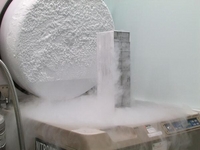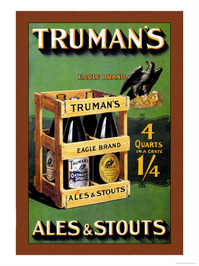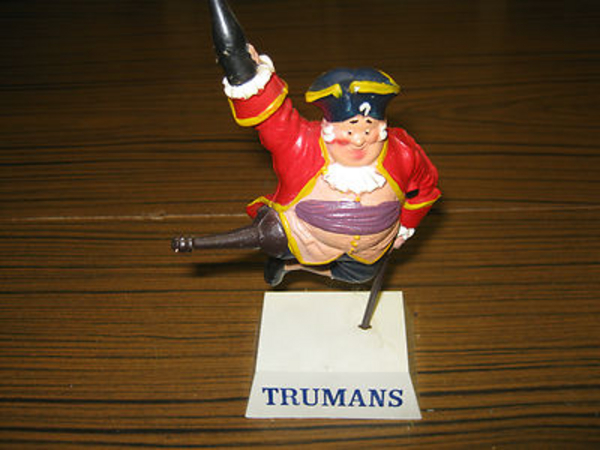Yeast brings Truman's hopping back to life
Added: Monday, July 8th 2013
It was like a scene from a science fiction film. Chris Bond, a genial and talkative man, suddenly disappeared behind a hard hat and a large visor and donned a pair of enormous gloves that covered his hands and arms.
He opened the lid of a container and what looked like steam came gushing out. But it wasn’t steam. It’s liquid nitrogen, used to store samples of yeast at a temperature so low -- minus196 degrees C -- that it defies comprehension (see top image). From out of the freezing mist it was possible to detect that Bond was holding a long container. Inside were yeast cultures that are vital to the health and well-being of breweries.
Brewing is no longer a mystery. Thanks to the many books written about beer in recent years, most people are aware that beer is made from grain, hops and water. But scant attention is given to another vital ingredient: yeast. Without yeast there cannot be beer.
A famous American brewer Fritz Maytag, owner of the Anchor Brewery in San Francisco that helped kick-start the brewing revolution in the United States, put it well when he told me: “Brewers assemble the best ingredients they can then they step back and let nature takes its course.”
For nature, read yeast. Yeast is about life and civilisation. Many millennia ago, in the old world of Egypt, Babylonia and Mesopotamia, hunter-gatherers started to form settled communities in order to grown grain and use the grain to make bread and beer. The catalyst was yeast: the ancient people, without any scientific understanding, knew that the froth created when sodden grain was left in the atmosphere would cause their bread to rise. And yeast also made a rough but pleasurable form of alcohol when it fermented the liquid used in the bread-making process.
We know far more about yeast today and I went to learn and appreciate it better by visiting the National Collection of Yeast Cultures in Norwich, alongside the University of East Anglia. NCYC is a publicly-funded institute that has a collection of 4,000 yeast strains that are used in the food and pharmaceutical industries as well as in brewing.
Every sensible brewery in Britain deposits a sample of its yeast with NCYC. If a brewery gets a yeast infection it can quickly get a fresh sample from Norwich. A few years ago, Jennings brewery lost its yeast as a result of the floods in Cumbria. Within hours, a tiny ampule of Jenning’s yeast was on its way to Cockermouth where it was grown in a broth of glucose and maltose and was ready for action within five days.
NCYC does more than just store brewers’ yeasts. It checks strains on a regular basis to monitor any changes in the sample deposited in Norwich and the one in current production. It looks for any wild yeasts in a culture that could lead to beer with a bad flavour and it compares strains from different breweries where a company has more than one site.


I went to NCYC with Jack Hibberd, the general manager of Truman’s Beer in East London. I have been following developments at Truman’s since it was announced a new brewery would be built in Hackney Wick with the full rights to use the brand names, logos and recipes from the famous Truman Brewery in Whitechapel – once second only to mighty Bass – that opened in 1666 and closed in 1989.
The new Truman’s brewery plans to launch its first beers at the end of July. In order to create the right aromas and flavours, Hibberd and colleagues want to use the original Truman’s yeast cultures that are still stored at NCYC. In fact, a total of six old Truman’s yeast strains are held at Norwich but four of those are lager cultures: towards the end of its life, Truman’s, part of the Grand Metropolitan group, had to brew lager as well as ale.
The ale strains pose the question whether Truman’s had two different yeasts to brew mild and bitter. The brewery was a renowned producer of mild ale and porter but added pale ale and bitter when the styles became popular in the 19th century (pictured: crate of Truman's ales and stouts from the Whitechapel brewery).
At the peak of the craze for pale ale and India Pale Ale, Truman’s opened a second brewery in Burton-on-Trent and it’s possible that one of the Truman’s yeast strains originated in Burton, ancestral home of pale ale in the 19th century.
At the new Truman’s, brewer Benedict Ott will consider which of the two strains – or a mix of both – will be used to produce Truman’s Runner and Swallow & Swift, the first two beers. Porter will follow in September, an exciting prospect as a genuine Truman’s dark beer from the 18th century is recreated.
A great name in London brewing is on its way back and its beers will have an authentic character thanks to the help of NCYC in Norwich. As Jack Hibberd says: “A brewery’s yeast is what makes its brews unique. If hops provide the flavour and malt the body, then the yeast is a beer’s soul.”
*First published in Publican’s Morning Advertiser, 4 July 2013.Below:the Truman's pirate used post-World War Two to promote its beer with the slogan "There are more hops in Ben Truman".









